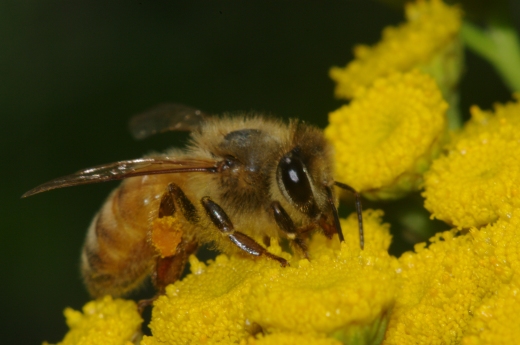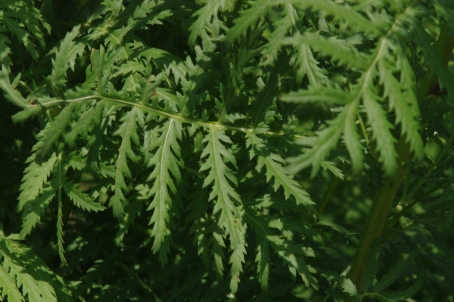 It’s late July and the bees are kicking into gear on the tansy. I never gave tansy much thought, in fact I never really took much notice of it at all until It started growing in my yard years before I kept bees. Tansy is rather tall. It grows to over four feet here in Western Massachusetts. It’s considered a wildflower but you have to look close to realize that the little yellow “buttons” are actually flowers. You don’t see the typical petals as on other flowers.
It’s late July and the bees are kicking into gear on the tansy. I never gave tansy much thought, in fact I never really took much notice of it at all until It started growing in my yard years before I kept bees. Tansy is rather tall. It grows to over four feet here in Western Massachusetts. It’s considered a wildflower but you have to look close to realize that the little yellow “buttons” are actually flowers. You don’t see the typical petals as on other flowers.
The book Plants and Beekeeping by E.N. Howes, published by Faber and Faber says this about tansy:
“Honey bees do visit the flower heads…..and have been observed probing for nectar as well as gathering pollen. However they do not visit in large numbers” American Honey Plants by Frank C. Pellet doesn’t have a listing for tansy as a bee plant.
Nevertheless, the honey bees are out there all over my tansy, joined by bumblebees, other native bees and other insects.
 Its a little tough to get good photos with a macro lens, as the bees don’t stop in one spot for long, working the flowers very quickly. Your best bet is to catch one sucking up some nectar as in the photo above.
Its a little tough to get good photos with a macro lens, as the bees don’t stop in one spot for long, working the flowers very quickly. Your best bet is to catch one sucking up some nectar as in the photo above.
I’ve heard and read that tansy acts as a mosquito repellent, so I decided to give it a try. One night before going to an outdoor play in an area that had plenty of mosquitoes, I picked some tansy leaves in the front yard and brought them with me. When we got there, I crushed the leaves and put some in the collar of my shirt, hat brim and on my lap. Although some mosquitoes buzzed around me, I didn’t get a single bite. I would have to experiment more to see if it was actually the tansy that worked, but I will surely try it again. Tansy is also used in the garden to ward off harmful insects.
Here is some information from,and a link to the site Our Herb Garden: http://www.ourherbgarden.com/tansy-companions.html
“Tansy is reputed to be a general insect repellant, deterring many non-nectar eating insects. Our research found that tansy is reported to specifically repel Ichmeumoid wasps, Japanese beetles, striped cucumber beetles, squash bugs, sugar ants, mice, fleas and moths. Tansy is particularly attractive to honeybees. Be cautious where you plant tansy as it is quite toxic to many animals. Never plant tansy where livestock browse or graze.”

I was searching Tansy today b/c I found some growing on this old farmstead we’ve been rehabbing. I have one hive (my 1st year w/ bees), but didn’t see any bees interested in it,. So I was intrigued when I found your comments. I have found ‘my girls’ & every other wild bee loves a plant called Motherwort. Are you familiar w/ this plant?
I wasn’t aware of it, but I will check it out. Thanks. I wonder if they bees around here make use of tansy because there is so much of it. It’s covered with all kinds of insects and native bees.
I am trying to find out if the honey that bees make from the tansy is toxic.
Hi Carol, I haven’t found any information that says honey from tansy is toxic. It isn’t in any of the lists I’ve seen for toxic honey, even though parts of the plant are toxic. I also don’t find it in any of the books I have on honey plants so it probably isn’t a significant source of nectar. Here in the Berkshires it’s just one of a wide variety of plants the bees are foraging on in any given time. Some plants like Rhododendron do produce toxic honey, but even then, there’s usually so little nectar brought back from Rhododendron compared to other plants that it’s affect is diluted to a harmless level. Although Bumblebees seem to love rhododendron, I hardly see honeybees foraging from it even in neighborhoods that have bee hives a few houses away. I hope this answer helps.
Skep beekeepers used tansy in their smokers.
I know that tansy causes abortions. Do you know if honey made from bees visiting tansy will have this effect?
Barbara, thanks for your question. This answer is my opinion based on researching the books I have on honey plants and sources, and also searching the internet. Be aware that I am a beekeeper and not a medical professional. There are a few plants that come to mind when it comes to honey that is toxic to humans. Two are rhododendrens and buckeye. I haven’t seen any evidence that bees foraging on tansy will produce toxic honey. One thing to keep in mind is the quantity and distribution of the plants. When tansy is in bloom, it provides just a small percentage of forage for honey bees, at least in the area of Massachusetts where I live. That’s why I don’t sell varietal honey. The bees forage from a wide variety of plants so any one nectar source is greatly “watered” down with many others. None of the books I have list tansy as a major honey plant, so I don’t believe it would be a problem. Bees forage on poison ivy flowers, but there is no danger in eating the honey they produce. As in any case, if you are really worried you can buy varietal honey, but be aware that it’s hard to say the bees foraged 100% on just one type of plant.